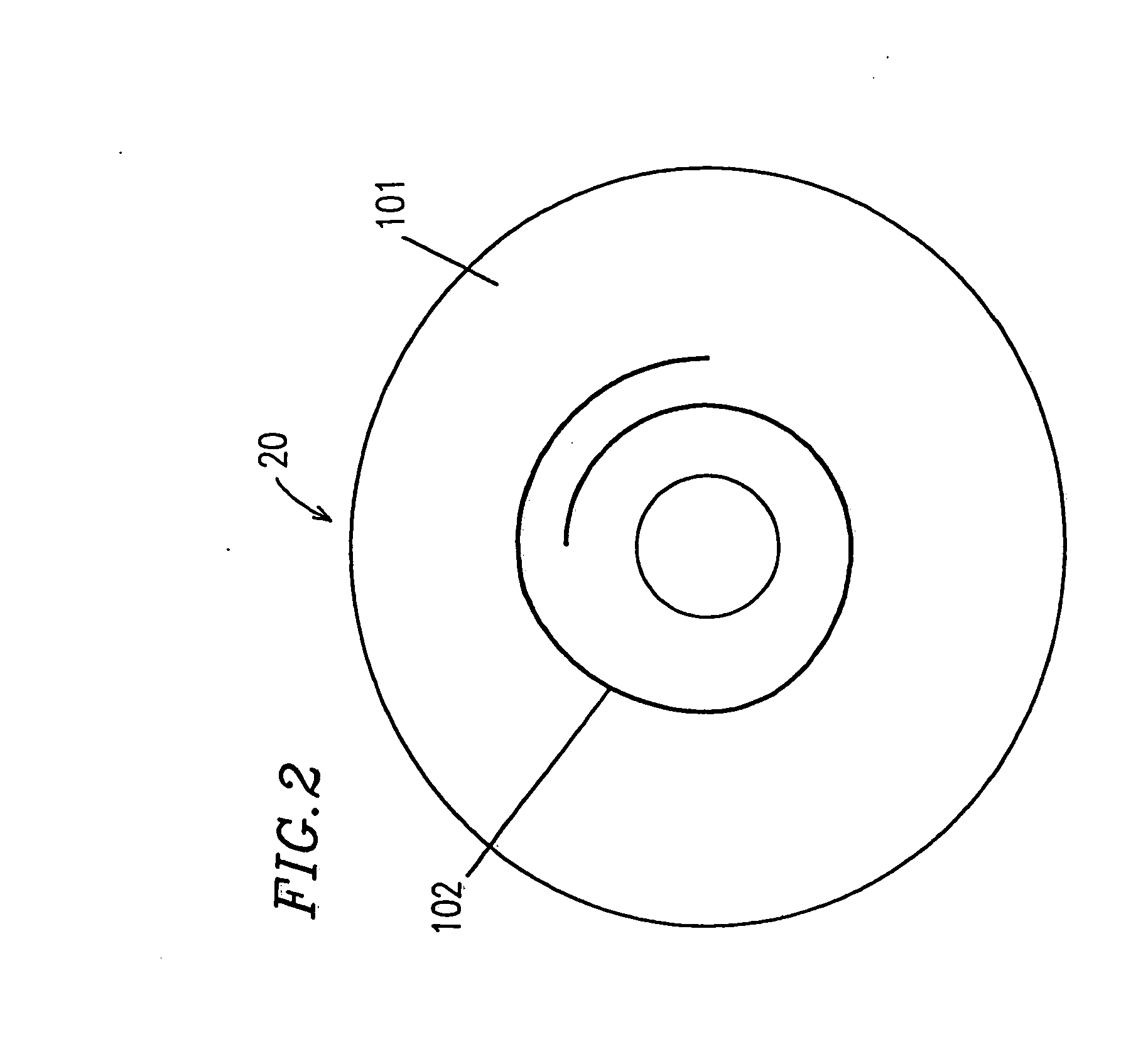Optical disc and physical address format
a physical address and optical disc technology, applied in the field of optical disc media, can solve the problems of unfavorable recording, inability to detect/correct digital signals,
- Summary
- Abstract
- Description
- Claims
- Application Information
AI Technical Summary
Benefits of technology
Problems solved by technology
Method used
Image
Examples
example 1
[0092]FIG. 2 shows an optical disc medium 20 according to Example 1 of the present invention. The optical disc medium 20 has a recording face 101, which has a spiral track groove 102 formed therein. As shown in FIG. 1, the track groove 102 has shapes which are different on a block-by-block basis. In FIG. 1, a block mark (identification mark) 210 is a cut-off portion in the track groove 102 and shows an index indicating a leading end of each block.
[0093] Each block is divided into N number of sectors 25 (N=32 or 16), and each sector 25 (sub block) is divided into M number of frames #0 through #25 (M=26). Each frame (fundamental unit) has a prescribed number of wobbles 26 or 27 in a periodical manner. The wobbles 26 and 27 have different prescribed shapes from each other, and represent sub information (“0”, “1” or “S”). One type of sub information (“0”, “1” or “S”) is represented by one shape of wobbles 26 or 27. The type of sub information and the shape of wobbles (wobbles 26 or 27)...
example 2
[0113]FIG. 3 shows a track groove 10 according to Example 2 of the present invention. The track groove 10 can be formed in the optical disc medium 20 shown in FIG. 2 instead of the track groove 102 shown in FIG. 1. In this example, the track groove 10 has wobbles 28 indicating sub information “S” recorded in a frame 24 in addition to the wobbles 26 in the frame 22 indicating the sub information “0” and wobbles 27 in the frame 23 indicating the sub information “1”. As in Example 1, address information is represented by a combination of sub information “0” and sub information “1”. The sub information “S” is provided at a leading end of the block, and used for indicating the leading end of the block instead of the block mark 210 shown in FIG. 1. In this way, the overhead required for the block mark 210 can be eliminated. In this example, the wobbles 28 representing the sub information “S” have a steep rising gradient and a steep falling gradient.
example 3
[0114]FIG. 4 shows a track groove 11 according to Example 3 of the present invention. The track groove 11 can be formed in the optical disc medium 20 shown in FIG. 2 instead of the track groove 102, shown in FIG. 1. In the first and second examples, one shape of wobbles is repeated periodically in correspondence with one type of sub information, and wobbles having different rising gradients and different falling gradients are used for different types of sub information. In this example, wobbles 29 and 30 are formed so as to have different duty ratios in accordance with the type of sub information. More specifically, as shown in FIG. 4, the wobbles 29 indicating sub information “0” recorded in a frame 32 is wider in one of a ridge or a trough (in the trough in the example of FIG. 4), and the wobbles 30 indicating sub information “1” recorded in a frame 34 is wider in the other of the ridge or the trough (in the ridge in the example of FIG. 4). Such a feature eliminates the necessity ...
PUM
| Property | Measurement | Unit |
|---|---|---|
| radius | aaaaa | aaaaa |
| radius | aaaaa | aaaaa |
| radius | aaaaa | aaaaa |
Abstract
Description
Claims
Application Information
 Login to View More
Login to View More - R&D
- Intellectual Property
- Life Sciences
- Materials
- Tech Scout
- Unparalleled Data Quality
- Higher Quality Content
- 60% Fewer Hallucinations
Browse by: Latest US Patents, China's latest patents, Technical Efficacy Thesaurus, Application Domain, Technology Topic, Popular Technical Reports.
© 2025 PatSnap. All rights reserved.Legal|Privacy policy|Modern Slavery Act Transparency Statement|Sitemap|About US| Contact US: help@patsnap.com



